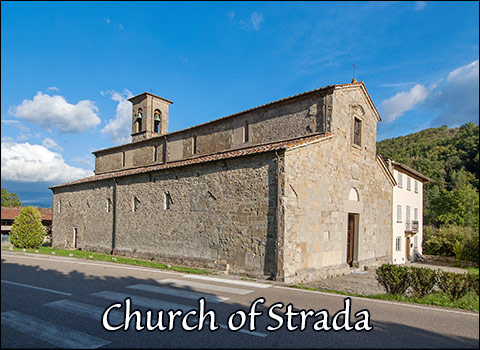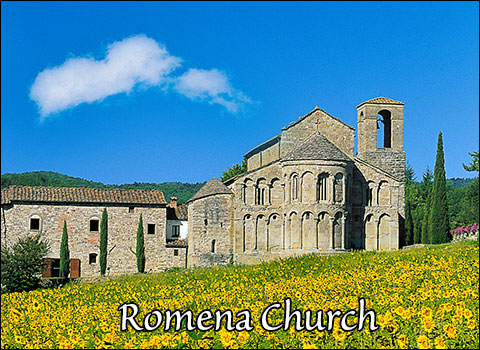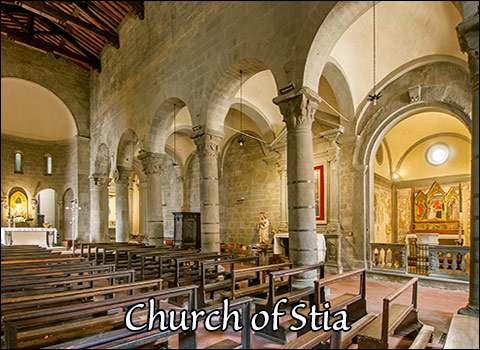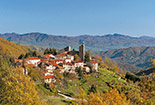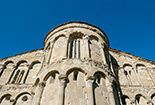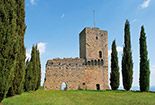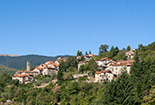Parish church of Montemignaio
in Casentino, a Tuscan valley with which you can get familiar in every detail through this site
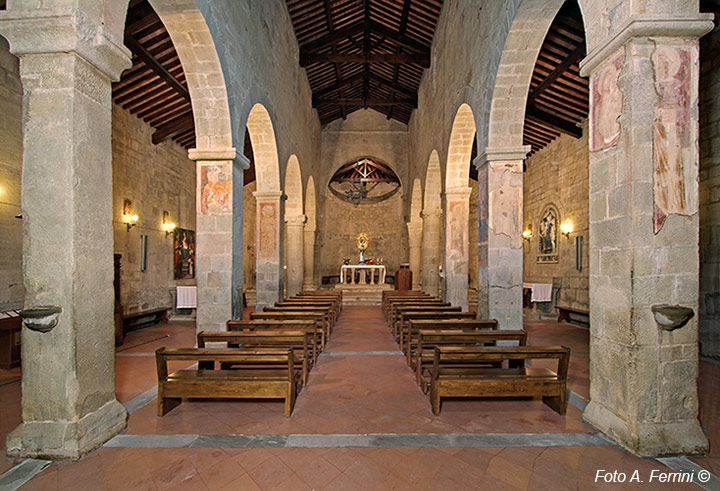
Texts and photos by Alessandro Ferrini ©
18 accurately described images of Pieve of Montemignaio. Click to enlarge
The Church of Montemignaio, the Romanesque in a mountain village
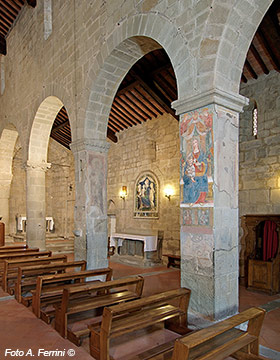 The area of Montemignaio, like the rest of the upper Casentino, belonged to the Counts Guidi since the eleventh century.
The area of Montemignaio, like the rest of the upper Casentino, belonged to the Counts Guidi since the eleventh century.
Also for the church of Montemignaio, as for the ones of Romena, Stia, Strada in Casentino and their “sisters” in Valdarno of Scò and Cascia, there is a legend that it was built thanks to a significant bequest by Countess of Canossa, dead in 1115. A tradition that does not have any historical foundation, it is much more probable that it was constructed, as the others in Casentino, by the Guidis’ will and financing, the Lords of these places. The church, dedicated to Santa Maria Assunta, surely took the place of another church and its construction, begun around the mid-12th century as well, took longer than the other churches in the valley. Its history is marked by many refurbishments, modifications and stabilizations during the centuries. This happened because some parish priests decided to change its aspect and functionality, but mostly to face some structural failures due to the movements of a not very consistent land on which the church was built. Renovations were also done recently. In 1904 the apse and the façade, which were in a very precarious state, were completely rebuilt. The first was enlarged so that it became disproportional in respect of the rest of the building, and the second was completely changed in the aspect, adding two side doors and three big oculi. On the external walls very little remains of the 12th century Romanesque church, while a testimony of the original stones of the church - well squared and very much worn out is in the right part. At the end of it and next to the great apse, there is a bell tower.
This was probably obtained from a pre-existing watchtower. The upper part shows an evident subsequent reconstruction. The internal architecture is the same as the one of the other Romanesque churches with the classical three aisles, though at first glance, it appears very different. Doubtlessly, 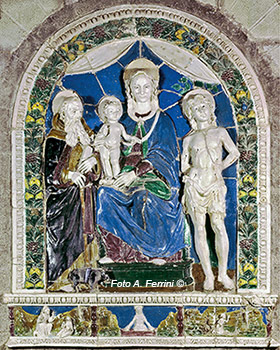 the inclination of the entire structure due to the land movements draws the visitor’s attention. Another different aspect is that, in front of the entrance, there are not mo- nolithic columns, but plastered pillars whe- re you can still see traces of frescos. These pictures can be dated back to the end 14th century, except for the second pillar on the right, made later (end of the 15th century) and conspicuous, which shows the Virgin with the Child sitting on the throne inside of a canopy whose curtains are opened by two angels. After three couples of pillars, in the presbytery zone, there are four columns. On top of these columns, there are capitals that, even though they present a less deep pattern than those of the other churches, have the same style, which confirms that they were carried out by the same masters, or, at least, they belonged to the same school. Another great value of the church of Mon- temignaio are some artworks of different type and times conserved here. Besides the already mentioned frescos on the pillars, in this church there are a 15th century painting attributed to Michele di Ridolfo del Ghirlandaio with the Virgin and Child in the throne with the Saints. In addition, a 17th century Annunciation on canvas by an unknown author, a glazed terracotta with the Virgin and Child between the Saints Antonio Abate and Sebastiano, dated around 1500 and attributed to Benedetto Buglioni. Last but not least in terms of artistic and devotional value, a picture dated first half of the 15th century attributed to the Florentine Rossello di Jacopo Franchi. This artwork illustrates the Virgin with the Child. This picture is known among the inhabitants of this area with the name “Madonna delle Grazie”.
the inclination of the entire structure due to the land movements draws the visitor’s attention. Another different aspect is that, in front of the entrance, there are not mo- nolithic columns, but plastered pillars whe- re you can still see traces of frescos. These pictures can be dated back to the end 14th century, except for the second pillar on the right, made later (end of the 15th century) and conspicuous, which shows the Virgin with the Child sitting on the throne inside of a canopy whose curtains are opened by two angels. After three couples of pillars, in the presbytery zone, there are four columns. On top of these columns, there are capitals that, even though they present a less deep pattern than those of the other churches, have the same style, which confirms that they were carried out by the same masters, or, at least, they belonged to the same school. Another great value of the church of Mon- temignaio are some artworks of different type and times conserved here. Besides the already mentioned frescos on the pillars, in this church there are a 15th century painting attributed to Michele di Ridolfo del Ghirlandaio with the Virgin and Child in the throne with the Saints. In addition, a 17th century Annunciation on canvas by an unknown author, a glazed terracotta with the Virgin and Child between the Saints Antonio Abate and Sebastiano, dated around 1500 and attributed to Benedetto Buglioni. Last but not least in terms of artistic and devotional value, a picture dated first half of the 15th century attributed to the Florentine Rossello di Jacopo Franchi. This artwork illustrates the Virgin with the Child. This picture is known among the inhabitants of this area with the name “Madonna delle Grazie”.
